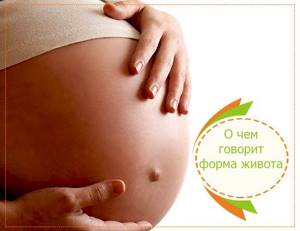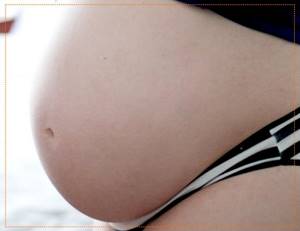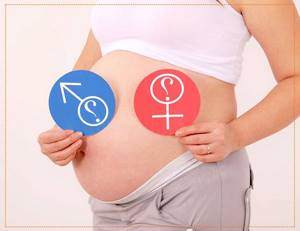What shape should the belly be during pregnancy?
From about the middle of the second trimester, a woman’s tummy noticeably enlarges, and from that time on, the doctor pays special attention to examining it. Since there are many nuances on which the shape of the abdomen depends, there is no norm in this matter, but there are signs by which one can determine whether the fetus is developing and positioned normally in the mother’s womb.
The fetus in the womb takes a position in which it is comfortable and continues to grow. At the same time, the expectant mother’s belly also grows. The rounding of shapes comes from the pubic plexus. At first, the volume appears in the lower abdomen, below the navel, but the closer to childbirth, the higher the “bulging” rises. By the third trimester, the bulge reaches the height of the solar plexus.
As for the shape, there is no point in drawing an analogy with a regular circle. The shape of the abdomen can be not only round, but also pointed, pear-shaped, oval, as well as square, irregular and even asymmetrical. Irregular and strange shapes are also acceptable.
In obstetrics, the “ideal” shape of the abdomen is considered to be one that resembles a vertical egg. This means that the baby is positioned head down in the uterus, i.e. in the most convenient way for an easy birth. However, if the stomach has the shape of a transverse oval, this is not a problem, since very often the child takes the correct position in the later stages, shortly before birth.
In other words, any shape of the abdomen is considered normal if all indicators and tests correspond to the norm. There is no need to worry and worry in vain if the doctor makes a verdict about a favorable course of pregnancy.
A brief physiological excursion into the stomach
The epigastric region (internal cavity of the peritoneum) is the most vulnerable in the human anatomical structure. All vital organs of the gastrointestinal tract (gastrointestinal tract) are located here: liver with gall bladder, kidneys, spleen. Complex arrangement of small and large intestines. The lower sector of the peritoneum contains the organs of the genitourinary system. Any traumatic intervention or the onset of an inflammatory process will be accompanied by pain. Because the abdominal organic system is abundantly supplied with an extensive network of neuron receptors. Nerve fibers instantly respond to changes that suddenly appear in this area of the body.
Exactly, these spasmodic reflux contractions (pain) in the affected areas of the abdomen are defined in medicine by the diagnosis “Acute abdomen.” It’s not easy “it hurts, aches, twists in the stomach.” We are talking about the critical condition of a sick baby and his tummy. Therefore, you need to call an ambulance, and immediately!
What are the signs of a true “acute abdomen symptom”?
- A sharp, sudden pain across the abdomen, which disappears, but after a few minutes appears again, with increasing force.
- The abdomen is bloated and filled with gases (flatulence). Upon palpation (lightly tapping the anterior wall of the abdomen), an “empty” sound is heard.
- The pain radiates to the lower back, right or left hypochondrium.
- The child is breathing shallowly, breathing heavily, there is sweat on his forehead, and sticky sweat all over his body.
- Elevated temperature (37.5 – 38).
“Acute abdomen” in children (from 1 to 5 years old) is provoked by intestinal intoxication (viral, bacterial, microbial pathomicroflora). Any gastroenterological pathologies that develop rapidly. Not to mention how dangerous abdominal injuries are for a child (bruises from a fall, from being hit in the stomach by a ball).
The benefits and harms of onions
Unfortunately, but this is a fact! The lethal threat from sepsis, peritonitis, internal bleeding in children of the first 10 years of life, with a diagnosis of “acute abdomen,” is extremely high. Of course, if time is lost (more than 4-5 hours) after the onset of a painful condition with the child’s stomach, primary medical care is not provided on time.
What affects the shape of a pregnant woman's belly?
The shape of a pregnant woman's belly is influenced by many factors.
The first is the woman’s build . Typically, a woman who tends to be overweight or overweight has weak abdominal muscle tone. In plump girls of short stature, the stomach, as a rule, has a regular round shape, less often - square and pear-shaped, since the waist “blurs”.
If the fetus is large, the belly will most likely also be round. With a small weight of the fetus and mother, the abdomen is often pointed, very neat and miniature. A similar situation will occur if the mother has a large build, but is also tall.
In very thin women with a narrow pelvis, the tummy is also usually miniature, but against the background of a slender figure it appears large.
The position of the baby in the womb most affects the shape of the abdomen. Whatever figure the mother has, the elongation of the abdomen in the horizontal or vertical direction, as well as asymmetry, depend precisely on what position the baby took in the uterus. If the baby is positioned correctly, the stomach will be stretched from top to bottom. A horizontal oval is a sign of the child’s transverse position. If the abdomen has an irregular, asymmetrical shape, we are talking about oblique presentation of the fetus.
Not so much the shape as the size of the abdomen depends on the volume of amniotic fluid, or amniotic fluid. The shape of a regular ball is a sign of polyhydramnios, and a pointed one signals a small amount of amniotic fluid.
If two or more fetuses Obstetricians also note another pattern: during the first pregnancy, if it suddenly turns out to be multiple, the severity is usually directed upward, and during the second and subsequent ones, the severity is directed downward.
When determining the shape and size of the abdomen, an amazing paradox is often observed: the taller and larger the woman, the neater and more modest the belly looks, and vice versa.
The relationship between the anatomical and physiological characteristics of a woman and the shape of her abdomen can be summarized as follows:
- The more trained the abdominal muscles are, the smaller the belly;
- If the abdominal muscles are weakened, it will reach an impressive size;
- The larger the fruit, the larger the belly;
- With multiple pregnancies, the belly grows quickly and becomes very large;
The key factor by which a gynecologist determines the presence of pregnancy during examination is the condition of the uterus and its cervix. As a rule, the organ increases in size, becomes thicker and longer. But this indicator is not always enough to make an accurate diagnosis. The doctor must conduct a survey to collect anamnesis, analyze accompanying symptoms and give a referral for a general blood test. Only after this the woman officially receives a new “status”.
Belly shape during pregnancy
A woman changes during pregnancy : her personality traits become softer, her movements become smoother, her mood changes. But the main metamorphoses occur in the stomach. The growth of the abdomen during pregnancy depends on many factors. The main ones are: the size of the baby, the amount of amniotic fluid and enlargement of the uterus, the physiological characteristics of the expectant mother’s body. These include the lifestyle of a pregnant woman: her gastronomic preferences during the 9 months of waiting and her attitude towards physical exercise. No two women have the same belly. Moreover, even in the same mother, the belly during the first and subsequent pregnancies may differ, because each of them is unique.
Baby's life
The official start date of your pregnancy from an obstetrics and gynecology point of view is the first day of your last menstruation.
Determining exactly when life began is sometimes difficult, so doctors have unified the starting point. The future baby grows and gains weight from the first weeks of development, but by the middle of the second trimester this increase is so symbolic that it practically does not affect the increase in the mother’s belly. Ultrasound examination allows you to see the embryo for the first time at the 2-3rd week of development; the diameter of the ovum at this period is 2-4 mm. At the 8th week of development (10th obstetric week of pregnancy), the diameter of the ovum is already 22 mm. And after another 2 weeks, we can talk about the indicators of the child himself: his height reaches 6-7 cm, and body weight - 20-25 g. By the end of the 16th obstetric week, the height will almost double, and the weight will increase by as much as 4 times. Now you notice that your tummy is beginning to round, and after 4 weeks your position will become noticeable to others. The active growth of the abdomen during this period is due not only to the rapid development of the baby, but also to an increase in the volume of amniotic fluid, which provides the child with comfortable living conditions. 20 weeks with a height of 25-26 cm, weight 280-300 g 24 weeks with a height of 30 cm, weight 600-680 g 28 weeks with a height of 35 cm, weight 1000-1200 g 32 weeks with a height of 40-42 cm, weight 1500 - 1700 g 36 weeks height 45-48 cm, weight 2400-2500 g By the time of birth, height 48-53 cm, weight 2600-5000 g The size of the expectant mother’s abdomen also depends on the amount of amniotic fluid in the uterus. Amniotic fluid is very important for the full development of the child: it protects it from adverse external influences, creates conditions for free movement and provides nutrition, protecting the umbilical cord from compression between the walls of the uterus and the body of the child. The volume of amniotic fluid is determined by the natural needs of the baby’s intrauterine development. At the end of the first trimester it does not exceed 100 ml, by 18 weeks it is already about 400 ml, and at the end of the third, until the 37-38th week of pregnancy, there is almost 1-1.5 liters of amniotic fluid in the uterus.
Krokhin house
The uterus enlarges and changes its shape from the first weeks of the baby's development. Before pregnancy, the uterus weighs about 50-100 g, and is shaped like a pear (it retains this shape in the first months of pregnancy).
At the end of the 2nd month, “Krokhin House” is rounded and becomes almost 3 times larger. By the third trimester, the uterus acquires an ovoid shape, its volume at the end of pregnancy increases by more than 500 times, and its weight reaches 1 kg. The gynecologist determines how correctly the uterus grows in the early stages of pregnancy using ultrasound. When it extends beyond the pelvic bones, the doctor measures the height of the uterine fundus. The research method is simple: the distance from the upper edge of the symphysis pubis to the upper part of the uterus is measured with a centimeter tape. The number of centimeters roughly corresponds to the length of pregnancy in weeks. If the indicators differ significantly, the woman needs additional examination to exclude possible pregnancy complications, such as polyhydramnios or oligohydramnios.
The shape of the abdomen is an eternal subject of debate. Before the advent of ultrasound, it can be used to “reliably” determine the sex of the unborn child.
Scientists are unanimous that such a diagnosis is just a coincidence. In fact, the shape of the abdomen depends on the position of the child (longitudinal and transverse) and the mother’s physiology. Short and strong women always seem to have a larger belly than tall and slender ones . If the expectant mother has a narrow pelvis, the stomach looks somewhat pointed; with wide hips, it looks like an egg. Another factor on which the shape of the abdomen depends is the initial state of the abdominal wall muscles. If a woman is in good physical shape and has not neglected physical exercise before and during pregnancy, her tummy will be toned and neat. But if the muscles are not in good shape, it will become noticeable earlier, and the shape will be more rounded and saggy. The health of the spine and the spine of the corset is also important. During pregnancy, the center of gravity changes, the enlargement of the abdomen shifts it forward, therefore the thoracic and sacral sections of the spine deviate backward, and the lumbar spine - forward (shape S). - Did you find an error in the text? Select it, press Ctrl + Enter and we will fix everything! Good afternoon, dear moms and dads. Welcome to the administration of the site Motherhood
.
If you are on this page, then you are interested in the article Shape of the abdomen during pregnancy ? You can share it with your friends on social networks.
What should the belly feel like in early pregnancy?
In the early stages, sometimes the stomach becomes hard to the touch. In medicine, the condition is diagnosed as uterine hypertonicity, and women themselves call it “stone belly.” The level of progesterone in the blood decreases, the abdominal cavity becomes excessively hard and seems to “shrink.”
Uterine hypertonicity in the first trimester occurs in 60% of pregnant women. This is not a pathology, but a feature of the body.
Other sensations in the stomach in the short term:
- Tingling. Caused by a rush of blood to the uterus. Not accompanied by pain.
- Nagging pain in the lower abdomen. They are fickle in nature. They appear as a result of the production of the hormone relaxin and spraining of the ligaments in the lower abdomen and groin area.
- Bloating. A consequence of the restructuring of the gastrointestinal tract. The abdominal cavity frees up space for the unborn baby, and muscle tone decreases in the intestines.
It is important not to confuse normality with a painful condition. Acute, dull, cramping or prolonged nagging pain in the lower abdomen is an alarming symptom. In this case, you should immediately consult a doctor. Often, minor discomfort is a sign of physiological changes in the uterus, but the risk of pathologies that in the early stages can lead to termination of pregnancy cannot be ruled out.
Shape of the abdomen during early pregnancy
As soon as a woman becomes pregnant, she wants to quickly see her baby, how it grows and develops. During early pregnancy, a woman's belly is the same as usual. It begins to grow differently in all women - depending on the build, genetic characteristics of the mother and the fetus itself. This occurs around 10 to 18 weeks. At this time, you will already understand that the baby is gaining weight and requires additional space, which you can give him. The skin on the abdomen, chest and thighs during pregnancy is usually more elastic, as hormonal changes occur in the body, adapting the woman to bear a healthy fetus with the least stress on her emotional and physical state. However, of course, due to sharp fluctuations in weight during this period, the upper layers of the skin of many become thinner and torn - stretch marks form. In order to reduce the likelihood of stretch marks, you need to start taking care of yourself in the early stages of pregnancy , when the belly has not yet begun to grow. First of all, it's nutrition! The following must be included in the diet: vegetable oils, whole grains, eggs, beef, nuts, chicken, legumes, cheese. It is highly advisable to exclude flour and sweet foods. It is also necessary to moisturize the skin of the abdomen, thighs, and buttocks. Do this with a cream containing collagen and amino acids, or just olive oil. Be attentive to yourself: itching and discomfort are the first signs of stretch marks. After giving birth, you will see whether you have strong scars or whether your skin is completely clear. Postpartum care for a woman’s body is a separate, extensive topic.
Associated symptoms of pregnancy
In addition to the condition of the uterus, an “interesting position” has a number of indirect signs:
- absence of menstruation;
- nausea;
- the appearance of pigmentation on the face;
- change in the nature of discharge;
- hardening of the mammary glands;
- bluish tint of the vaginal mucosa.
People believe that with the onset of pregnancy, a girl’s taste preferences change: she craves salty, spicy, and sour foods. Some, on the contrary, develop toxicosis and lose their appetite.
Concomitant symptoms of pregnancy must appear simultaneously, otherwise one of the disorders may be a symptom of a disease of the genitourinary system or gastrointestinal tract.
Signs of pathology
The first 2 weeks of pregnancy are a critical period during which there is a high probability of the embryo being rejected by the mother’s body or the development of pathogenic factors influencing its development. The most common pathologies and their characteristic signs:
- Toxicosis. Manifested by nausea and vomiting of varying intensity. With a mild degree, the urge appears only in the morning, on an empty stomach. In rare cases, vomiting occurs up to 10-15 times a day, accompanied by dizziness, low blood pressure, and tachycardia.
- Anemia. A decrease in hemoglobin concentration is associated with a physiological change in blood composition. Manifests itself in the form of weakness, sleep disturbances, headaches, tinnitus, fainting, and shortness of breath.
- Spontaneous miscarriage - termination of pregnancy before 22 weeks under the influence of genetic, anatomical, endocrine factors, etc. It is accompanied by spotting, and in severe cases - bleeding. Back pain and menstrual cramps are also noted. When taken again, the test shows a negative result instead of a positive one.
Hypertonicity of the uterus cannot be called normal. However, in most cases in the early stages the phenomenon is temporary and does not progress. If a feeling of tension increases in the lower abdomen, cramping pain appears, you should immediately consult a doctor.
Why the belly grows in men: the main reasons
Diet violation
- Due to the active pace of life, most people do not have time to prepare healthy food. I have to snack on fast food.
- Hamburgers, pizza and other sandwiches are a treasure trove of calories. Men prefer to eat a lot until they completely satiate their body. This leads to excess calories and fat deposits in the abdominal cavity.
Harmful foods that cause belly fat in men include:
- Fried and fatty foods.
- Pickles.
- Smoked meats.
- Sweets.
- Bakery products.
- Pasta.

How do you eat and do you have any bad habits?
Bad habits
- Many men like to drink beer . And it doesn’t matter whether they do this when meeting with friends or while watching TV. But, this drink can provoke health problems, negatively affecting the liver and digestive tract. Remind your partner that beer makes men's bellies grow.
- Nowadays you can find many different beer snacks on store shelves. They also, and not just the drink, provoke abdominal growth in men. Fish, smoked sausages, chips and crackers are sources of unhealthy fats and calories.
- Some men who like to drink beer also enjoy smoking. This bad habit leads to a decrease in the amount of testosterone . This promotes slow breakdown of fats.
Lack of mobility
- The most common reason why the belly grows in men is insufficient activity throughout the day.
- If in young guys the abdominal muscles are characterized by elasticity and firmness , then in adulthood the opposite is true. Because of this, a large belly begins to sag and does not look aesthetically pleasing.
- As you age, the situation becomes more complicated as other health problems appear. complications with the heart, blood vessels and obesity may appear . of atherosclerosis often appear .

Due to lack of mobility
Stress
Almost every day a person faces stressful situations. In addition to nerve cells, other body systems are also affected.
There are several stressful situations that provoke abdominal growth in men:
- excessive emotional excitability;
- lack of sleep;
- psychological overload.
A hormone called cortisol . Therefore, you need to undergo regular tests to monitor its levels in the body.
Incorrect posture
- There are frequent cases when the stomach began to grow in men who are not at all inclined to be overweight. There is a high probability that the cause is hidden in spinal deformation.
- If curvature of the spine occurs, then all internal organs begin to shift. This leads to protrusion of the abdomen. As a result, the load on the back becomes variable and the tone of the abdominal cavity decreases. This leads to an enlarged belly.
- Try to undergo regular examinations with a doctor to identify problems with your spine in time. This will allow you to start treatment in a timely manner and prevent the growth of the abdomen.

Pay attention to your posture
Hormonal imbalances
- If a man begins to have a hormonal imbalance, then the abdominal cavity actively enlarges. Usually, representatives of the stronger sex encounter this situation after 40 years.
- At this age, testosterone is poorly produced, and the processes responsible for fat burning slow down. For this reason, in adulthood, men are faced with an increase in the layer of fat. Unspent calories are converted to fat.
Bloating and flatulence
- If you do not adjust your diet, you can cause bloating and flatulence. The reason lies in the fact that a lot of gases accumulate in the intestines.
- If you consume harmful foods, a fermentation process occurs . The result is swelling and seething. Be careful when consuming peas, beans, carbonated drinks and sweets.
Presence of diseases
If a man carefully monitors his diet and is not prone to bad habits, then abdominal growth can be caused by other reasons.
So, life begin to grow in men:
- liver diseases;
- malignant formations in the genital area;
- problems with the endocrine system;
- accumulation of fluid in the abdominal cavity;
- hernia;
- helminthic infestations.

If you know what exactly is associated with the growth of a man’s abdomen, consult a doctor. Only after a thorough examination can the true cause be determined.
How to relieve abdominal cramps
Hypertonicity of the uterus in the early stages is always accompanied by cramps in the lower abdomen. They are not dangerous to the fetus, but can cause discomfort to the expectant mother. There are many effective techniques to improve the condition and relax the muscles in the groin.
- Take a comfortable position while sitting or lying down and begin stroking your stomach clockwise.
- Take a relaxing, warm bath. The use of essential oils is prohibited, as they can increase muscle activity.
- Maintain bed rest and avoid stressful situations.
- If you have hormonal imbalances, get them treated. Together with your doctor, select suitable drugs that compensate for progesterone synthesis and antispasmodics.
- If you are deficient in vitamin B6, adjust your diet. Introduce spinach, carrots, various varieties of cabbage, nuts, strawberries, cherries, citrus fruits, legumes, fish and dairy products into the menu.
- Limit intimacy for a while to avoid causing a miscarriage.
- Take herbal teas before bed and throughout the day. The optimal drink recipe is 2 tsp. lemon balm, 2 tsp. mint, 1 tsp. valerian, 1 tsp. motherwort. You can refuse the latter due to personal taste preferences. Pour the mixture of dry herbs into a thermos with boiling water and leave for 30 minutes. Tea has an excellent calming and relaxing effect.
- Fumigate your living space with soothing and relaxing scents. You can use an aroma lamp, an amulet, or simply carry an aroma medallion with you. Myrrh fights stress and insomnia, rose relieves nervous tension and relieves nightmares. Classic esters of chamomile, lemon balm, mint, valerian, and geranium have a similar effect.
It is recommended to devote your free time to quiet activities. Sign up for yoga for pregnant women, learn breathing practices and meditation techniques. Special sets of exercises, when performed regularly, will improve blood supply to the placenta, prevent oxygen starvation of the fetus and help normalize the production of hormones. Also, don’t forget to walk in the fresh air and pamper yourself with positive emotions.

Conception and fetal development, in general, remains a secret and incomprehensible process to the human eye. Thanks to the improvement of modern technologies, medicine has stepped forward with very significant progress. For example, it has become possible to determine the sex of the unborn baby at the initial stage of pregnancy and monitor its development in the womb throughout the entire period of gestation. However, not every woman is in a hurry to undergo such an intimate examination using an ultrasound, so it will be interesting to find out what the shape of the abdomen during pregnancy may indicate and whether it is possible to determine from it whether the baby will be a boy or a girl.
Acute abdomen in children: what to do?
Does your child have a severe stomach ache? Incarcerated hernia, appendicitis, abdominal trauma - this is not a complete list of disorders that can lead to severe abdominal pain and which are united by one name - acute abdomen. In this case, jokes are bad - the condition can be very dangerous for the child, and you need to urgently consult a doctor. Today we will tell you what an “acute abdomen” in children is, how to recognize it and how to provide first aid to a child.
What it is?
An acute abdomen is a set of symptoms that signals that serious damage to the abdominal organs has occurred, requiring immediate surgical intervention.
What disorders and diseases cause an “acute abdomen”?
This condition is characteristic of many pathologies of the gastrointestinal tract and pelvic organs. Here are the main ones:
- appendicitis, - hepatic and renal colic, - intussusception (a disorder in which one part of the intestine penetrates into another, leading to intestinal obstruction) - strangulated hernia - intestinal obstruction - perforated gastric ulcer, - abdominal trauma with intestinal rupture.
Symptoms of acute abdomen:
- severe sharp pain in the abdomen - compaction in the abdominal cavity - vomiting - lack of stool - bloating and lack of gas production.
Very often, abdominal pain in a child is not dangerous and is associated with increased gas formation, intestinal spasms, and untimely bowel movements. In such cases, the pain (dull and unsharp) is mainly localized in the center of the abdomen - the child points to the navel area.
Non-dangerous abdominal pain in a child can develop when:
- Bowel problems such as constipation or irritable bowel syndrome. — Infectious diseases, such as gastroenteritis — Overeating, food poisoning or food allergies — Periodic pain in girls — Stress, etc.
In some of these cases consultation with a doctor , but these reasons do not relate to the diagnosis of “acute abdomen” and do not require hospitalization.
It happens that the cause of abdominal pain is not obvious, and it may take some time to determine it.
Prevention of acute abdomen in a child:
- avoid injuries to the abdominal area - treat and prevent liver and kidney diseases in a timely manner - identify and treat diseases of the gastrointestinal tract in a timely manner.
First aid for a child with abdominal pain:
- first, ask how long the child has been walking and put him on the potty - if defecation is difficult, give the child an enema - then - universal help for pain (rest (sleep), limiting physical activity, distracting positive emotions) - do not feed the child - Do not give your child painkillers - thermal procedures cannot be done.
After some time after cleansing the intestines, the child may feel better: the pain may go away and an appetite may appear. However, if you still have doubts and something is still bothering you, you should show your child to a pediatrician and pediatric surgeon.
You urgently need a doctor if:
- the pain is localized in the right lower abdomen (perhaps appendicitis); - the pain is sharp and severe, or it has moved to another place; - pain was preceded by injury; - vomiting lasts more than 24 hours, and the child does not retain fluids, or the vomit is green; - there are traces of blood in the stool or vomit; - have problems with urination (difficulty, pain); - the child has developed skin rashes; - abdominal pain is combined with pale skin and sweating, diarrhea and elevated body temperature, rash, drowsiness.
A child with an acute abdomen must be urgently hospitalized in a surgical hospital, where the surgeon decides what kind of treatment is required. Most often, with symptoms of an acute abdomen, surgical intervention is vital!
Important!
Pain in the groin and testicles in boys requires urgent consultation with a doctor (this could be testicular torsion and other serious disorders). Boys may be shy and say that their stomach hurts. Therefore, check with your child - let him show you exactly where it hurts!
Be attentive to your child! And be healthy!
Sizes and contours of the abdomen during pregnancy
Women who have already had experience of bearing a fetus most often pay attention to some features of the pregnant woman’s abdomen, by which they try to recognize what gender the baby will be. Although the abdomen has its own distinctive features, during examination the doctor most often determines the position of the fetus and the parameters of the uterus from them. However, doctors reject such beliefs that the shape of the abdomen during pregnancy can tell a lot about the condition of the child in the womb.
During pregnancy, the abdomen goes through various stages of changing its shape, from sharp and oval, to round and pear-shaped, and in some cases changes until childbirth.
What determines the shape of the abdomen during pregnancy, and what factors can influence such changes?
With the correct course of pregnancy, the belly has an oval shape, in the form of an egg in a vertical state, but this does not happen in all cases. Its appearance can be influenced by various factors, the location of the fetus in the womb or any others. For example, for the same woman, pregnancy can differ significantly from one another, and this affects the shape of her belly. Therefore, in one case during pregnancy, the stomach will be sharp, like a cucumber, and in another, oval or round, like a ball.

Factors that influence the circumference and shape of the abdomen during pregnancy:
- peritoneal muscle mass;
- the presence of fat deposits or their absence;
- rate of growth of fetal body weight;
- type of fetal position;
- amniotic fluid level;
- fruit size;
- number of fetuses in the womb;
- individual anatomical structure of a woman.
Abdominal size and body structure during pregnancy:
- The ideal shape of the abdomen during pregnancy is considered ovoid and slightly sharp.
- During pregnancy, in a representative of the fairer sex with a narrow pelvis, the tummy becomes sharp and is especially noticeable during the second trimester.
- In women with weak muscle mass, the abdomen during pregnancy is observed to be spherical and square in shape. A high level of amniotic fluid and a large fetus are also indicators of a voluminous tummy.
- In short ladies, the shape of the belly in position is large and circumferential.
- The pear-shaped form is most often observed in pregnant women with a weak muscular structure of the peritoneum; such a stomach is not able to hold the fetus in proper condition, therefore, it has the shape of a pear.
- A neat tummy is accompanied by low water levels, the volume of the fetus and its position. Such forms are characteristic of pregnant women with an elegant body composition and carrying a tiny fetus. The neatness of the shape directly depends on whether the woman is slim or not.
- Large, sharp forms can be observed when carrying two, three or more fetuses or due to anatomical defects of the woman.
- During primary pregnancy, the abdomen usually has an acute shape and grows from below, and during secondary pregnancy, from above.
- With a narrow pelvis it will protrude significantly forward, with a wide one it will spread out in all directions.
- Asymmetrical shape, indicates an uneven position of the fetus.
- The shape of the abdomen during pregnancy may depend on where the placenta attaches to the uterus. If it is fixed in the front part, the belly will stick out, and if it is in the back, it will be flat and unnoticeable.
- The belly sags during pregnancy, which means the fetus is located too low inside the uterus. In such cases, the doctor warns the pregnant woman and recommends wearing a special bandage.
The intrauterine position of the child has a fundamental function that influences the shape of the pregnant woman's abdomen. During the period of growth, the child in the womb makes various body movements and movements, which cannot but affect external manifestations.
About the belly of a pregnant woman after 12 weeks
From this moment, the unborn child begins to actively develop, and its weight increases. From week to week, the volume of the abdomen during pregnancy should increase.
Of course, every expectant mother notices the growth of her tummy much earlier than her relatives, friends, or husband. However, at 16-17 weeks it will become noticeable to others. During this period, the length of the unborn child is approximately 12 cm and the weight is about 100 grams. Despite such small, at first glance, indicators, the future baby already looks like a little man. He moves quite actively; some women already feel the baby’s movements at this stage.
By the middle of pregnancy - 20 weeks - the baby will gain 260-300 grams. The abdomen will be significantly rounded, the fundus of the uterus will be approximately two fingers below the navel. At this stage, you need to think about the condition of the skin on your stomach. The risk of stretch marks can be prevented with simple exercise, walking, and going to the pool.
By the 24th week of pregnancy, the tummy will grow, because the baby already weighs about 500 grams. The fundus of the uterus is at the level of the navel. Don't forget about proper, balanced nutrition. This will make it possible not to gain excess weight and will help reduce the already heavy load on the spine and legs.
The 28th week of pregnancy is the period when the baby has already received basic development, sufficient to be born ahead of schedule and survive. He gained about 1000-1200 grams. A whole life happens in the belly of a pregnant woman; the baby moves very actively, pushing with arms and legs. Depending on the position of the unborn child, the shape and size of a pregnant woman's abdomen may be different. At the same period, the abdomen of two women may be different. A small belly during pregnancy often occurs when the baby is located close to the spine. A large belly during pregnancy - if the fetus lies close to the anterior wall of the uterus.
By 32 weeks, the belly has taken on a shape that will most likely remain until delivery. During this period, the child takes the position in which he will be ready to be born. Of course, there are times when the unborn baby rolls over. The tummy is rapidly growing upward. The baby gains about 1800 g. weight by 32 weeks.
From 36 to 38 weeks of pregnancy, the height of the abdomen reaches its maximum point. Sometimes this causes inconvenience and even discomfort. The shape of the abdomen can be similar to a cone, a ball, or an oval. It all depends on the amount of water, the position of the child, and according to signs, the gender of the future little man. From this moment on, the stomach will drop down, which means that the meeting with your baby is close.
40th week of pregnancy – finish. The belly is already quite large, the baby weighs on average from 3 to 4 kg. If symptoms of beginning labor appear, you need to call an ambulance, calm down and wait for the long-awaited miracle to be born.
Pregnancy always progresses differently. Even for the same woman, the belly may differ during the first or subsequent pregnancy. Therefore, a pregnant woman’s belly week by week cannot be considered a rule; everything is purely individual. Enjoy your pregnancy and get the most positive emotions.
Weekly changes in abdominal shape during pregnancy
It is difficult to accurately determine the moment of conception, therefore in medical practice the first day of the last menstruation is considered the date of onset of pregnancy. From the set date, the countdown begins until the baby is born. Before finding out the sex of the child, you need to be patient, since with an ultrasound, the sex of the child can only be seen at 4-5 months of pregnancy.
In the recent past, they tried to determine the sex of the child by the shape of the pregnant woman’s belly; midwives, using such a primitive method, tried to predict the future of the baby. Ultrasound can show the embryo as early as 2-3 weeks, and allows you to monitor the further growth and development of the fetus throughout the entire period of gestation.
The shape of the belly, is there a mystery about the baby’s future hidden in it?
During pregnancy, can the shape of the belly tell who will be born, a boy or a girl? Doctors unanimously exclaim: “no, this is impossible!” But if we lean towards popular beliefs, then the shape of the abdomen during pregnancy and its significant differences, long before birth, can easily tell who is a boy or a girl in the womb.
For example, there are people who will knowledgeably tell you about the future of the baby, and when meeting a pregnant woman they know, they immediately use their abilities, appraisingly begin to look at the belly in order to predict who will be.
Some believe that a belly as sharp as a cucumber can be a boy during pregnancy, its appearance is always neat, especially from behind it is difficult to notice that a representative of the fairer sex is in position. But if during pregnancy the belly is vague, voluminous, round, then there is no question who will be, it is visible from all sides, it becomes clear to everyone that a girl will be born. In general, the girl’s mother experiences swelling in her body, her face loses its former attractiveness, as if the baby had taken some of it for herself.
Others argue that during pregnancy, if the belly is low, you can expect the birth of a girl, and a high one will indicate the appearance of a boy.

Causes of acute abdomen
These may be diseases that require surgery or emergency treatment. They occur in the gastrointestinal tract and in the abdominal cavity of the patient. Very often, in very young patients, the causes of such symptoms are appendicitis or intestinal obstruction.
Surgical diseases require immediate hospitalization of the child and an operation:
- These are injuries to the abdominal organs, resulting in internal bleeding.
- Appendicitis in acute form.
- Intestinal obstruction.
- Impaired blood flow in internal organs.
Diseases that require immediate treatment:
- Infectious diseases of the pelvic and abdominal organs.
- Metabolic disorders.
- Pleurisy or pneumonia.
In the case of these diseases, surgery is not required; the doctor will prescribe medication. It is worth remembering that the main key to successful treatment is a correctly established diagnosis of the disease.
If, with an acute abdomen, a child (3 years of age or older) is provided with unqualified assistance or sees a doctor too late, the outcome may be fatal. What can be done to prevent this? You need to seek qualified medical help as quickly as possible.










